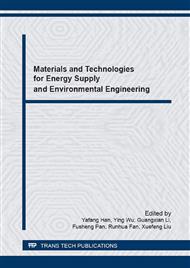p.479
p.485
p.490
p.497
p.505
p.510
p.519
p.527
p.532
Research on a Coated Method for Ceramic Proppant
Abstract:
Due to the disadvantage of the traditional proppant, such as the low strength, poor acid corrosion resistance, embedding and flowback and so on, a new coated proppant was developed to deal with these problems. As the coating material, the natural gel was used to coat proppant. Different from the traditional mechanical mixing method, the means to make coated ceramic was the solvent dispersion method through the process of emulsification, cross-linking and dehydration dispersion. The strength of coated proppant was tested in different coated conditions. According to the result of test, the ceramic was coated under the optimum condition. Then the roundness, sphericity, acid solubility, crush resistance and surface structure of coated ceramic were compared with the uncoated ceramic. The experimental results showed that the optimal condition was as follows: 0.08 g/ml of gel concentration, 15/2 of ceramic/gel (g/g), 0.025 g/ml of emulsifier concentration, 20min of emulsifying time, 1/10 of water/oil rate. The coated ceramic prepared at this condition had the best performance, compared with the common ceramic, and its sphericity and acid solubility were greatly improved, bulk density reduced 7%. And the proppant surface was very smooth, the crush resistance was almost zero.
Info:
Periodical:
Pages:
527-531
Citation:
Online since:
March 2016
Authors:
Keywords:
Price:
Сopyright:
© 2016 Trans Tech Publications Ltd. All Rights Reserved
Share:
Citation:


